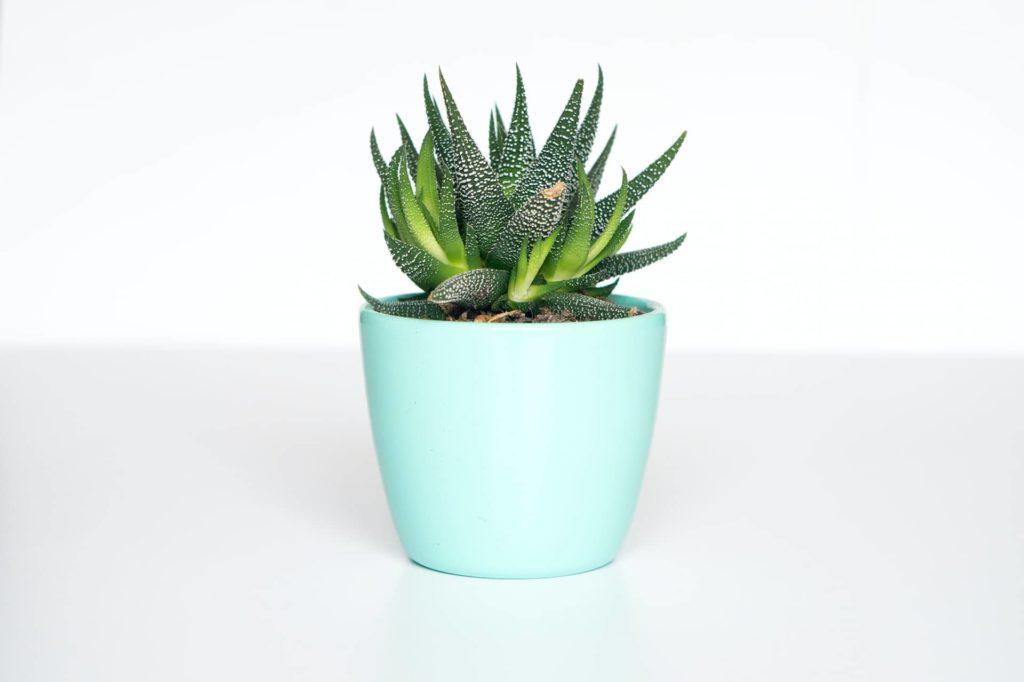Succulents can be great houseplants. Because it is beautiful, and low maintenance required when compared to other houseplants. So you wondering: how to water succulents indoors! In this article, we gonna answer this question in detail.
And talk about the factors that determine how often you should water your indoor succulents. Plus how to water them if your pot without drainage holes.
Also, we will discuss how to tell whether your indoor succulents are underwater or overwatered. And the best type of water to use on your indoor succulents.
But before diving deep into the details I will put the answer to our main question as simple as this: how to water succulents indoors? The right way to water indoor succulents is by soaking their growing medium (soil) and allow the pot to drain any excess water. And water them again only when the soil is completely dry. Keep reading to know the factors that affect the watering schedule.

Factors that determine the indoor succulents watering frequency
There is no universal watering schedule for watering indoor succulents. The watering frequency will depend on different factors. Those factors are:
Pot size
The bigger the pot size that contains the succulents the less watering you may apply. Because a bigger pot contains more soil which retains more moisture and water.
On the other hand, the smaller the pot size the more watering you may need to make your succulents thrive.
The weather
During spring and summer, succulent consumes more water. Because of two reasons: First, in summer the evaporation rate will be higher than in the fall or winter.
The second reason is that in spring and summer succulents are in their growing season, So they are actively growing. Such growth needs more energy. So they consume more water in order to produce more energy.
While in winter most indoor succulents will go dormant. They are not actively growing. Instead, they consume way less energy, there are focusing on resting. Therefore indoor succulents will need less water during fall and winter.
The above are the factors that determine how often you should water your indoor succulents.
See also: How to water succulents in moss
The right way to water indoor succulents
Now you know what determines your watering schedule. But you need a more solid and specific rule for the watering. I got that!
The right way to water your indoor succulent is by following the soak and dry method. Such a method applies that you give your succulent soil abundant water soak until the water drains through the drainage holes.
And Only water them again when the soil is completely dry. By doing so you encourage the roots to grow in order to search for water. Such a thing will make the root system strong which will make your plant able to stand long periods of drought.
This is the most important advice when watering indoor succulents. Only water them when the soil is completely dry. The second most important advice when it came to watering indoor succulent is to use a potting mix that drains well.
Cactus and succulent potting mix with soil particles that is 6mm will be great. Indoor succulent have a lower evaporation rate when compared to outdoor ones.
Because in the outdoor environment there is plenty of light and heat. So you need to make sure to plant your indoor succulents in well-draining soil.
The third most important advice is to use a pot with drainage holes especially if you are a beginner. Although you can still use a pot without drainage holes for your indoor succulent I will discuss that later in this article. But it is not the recommended approach.
Do indoor succulents need misting
Never mist your indoor succulent. Because there is no enough light and air in indoor environments. Therefore the water that sticking in the succulent leaves and stem will stick for a long period of time which may lead to rot.
Misting is only applies to water succulent cuttings. Also, water your indoor succulents in the morning. And carefully only pour the water in the soil, not in the stem or leaves.
Now you know how to water your indoor succulent. Let’s examine the tips I told you with how succulent deals with water in its natural habitat. In order for you to have the big picture.
How succulent gets water in the deserts
Both indoor and outdoor gardening success depends on the grower’s understanding of his plants’ needs. The best way to understand your succulent’s water needs is by knowing how they live in the deserts.
Succulents are native to deserts or semi-deserts regions. Where there are few frequent rainfalls. And long drought periods. The rain in deserts can last for two days.
And then will be drought for months until the next rainfall. Also, the sandy soil in the deserts drains water quickly. Therefore succulents adapted to such conditions by fast water absorbant and storing water in their roots, leaves, and stems.
This is why the soak and dry is the optimal approach to water your indoor succulents. Because by doing so you are mimicking its natural habitat.
How to know whether indoor succulents are underwater or overwatered
As I mentioned earlier the good sign to look for watering your succulents is the dryness of the soil. Don’t be fooled by the upper soil part drought.
The upper soil may be dry if you gave it a look or even if you tested with your finger. But still, the lower soil where the roots lay is moist.
Therefore test the soil from the bottom by inserting your finger in the drainage hole. If you find it dry, give your soil a good water soak.
Signs that succulent is underwatered
It is a fact that succulents can stand a relatively long period of drought. But if you over neglect them and underwatered them. They will show signs of dissatisfaction.
If succulent is underwatered it will have wilting, wrinkly, and shriveling leaves. Also, a lot of bottom leaves will turn to brown color and will be a lot of dropping.
Don’t be confused with dropping leaves that caused by normal aging. Healthy succulent may drop its bottom leaves as normal aging ( the resources shift from old leaves to the new growth).
But in the case of overwatering, the bottom leaves dropping will be intense and severe. If you notice such signs you need to reflect on your watering habits. how often you water your indoor succulents.
If the answer is you don’t even remember, most properly your succulent is underwatered. You fix the problem by gently give them more water. Don’t change your watering schedule dramatically.
In order to not shock the plant. Just slightly increase the watering until your plant recover. Make sure to only water the plant when the soil is completely dry.
You don’t want to overwater your succulent. Because underwatered succulents can easily be saved but overwatered succulents it is hard to be saved. It is better to underwater them than to overwater them.
Signs that succulent is overwatered
Those are the signs you don’t want to see. Because overwatered succulent is near to the death side than the life side. Succulents are prone to root rot, which caused by overwatering.
Especially indoor succulent because there is less evaporation rate in indoor environments. When succulent is overwatered, it will have swelled leaves that will look like they will explode.
Because succulents store water in its leaves it will absorb water and transfer it to the leaves. When the leaves look like they hold water that is more than what it can take, it is a sure sign that your succulent is overwatered.
Also overwatered leaves will feel mushy and soft. They will lose their firmness. Also, the leaves may turn to yellow or translucent. The core goal of indoor succulent’s watering advice is to not get to this point (overwatering).
I remember when I was a child all I knew about caring for plants is to water them, whenever I came near to one of our houseplants I water it.
Please don’t be like that kid! it is hard to save succulent that overwatered. However, I wrote an article about how to prevent and treat root rot caused by overwatering.
How to water indoor succulents that planted in a pot without drainage holes
Planting succulents in a pot with enough drainage holes is the best approach. Especially indoor succulents. Because besides the excessive water have no place to go also the evaporation rate in the indoor environment is low.
However, some people insist to grow their indoor succulents in pots without drainage holes for different reasons. Technically you can still grow succulent in a pot without drainage holes.
But you need to be very careful with the watering. The rule is that you have to pour water in the pot that equals what the succulent’s roots can comfortably absorb without any accessive water.
Any excessive water will set in the soil for a long period of time which will eventually cause roots rot. Personally, I grow succulent indoor in a pot without drainage holes for experiment purposes.
I found that the right amount of water equals half of the potting medium. For example, if your pot contains soil that equals to parts of x container. You should give your succulent when the soil is dry 1/2 x.
Don’t forget the golden rule for watering indoor succulents ” Only water when the soil is completely dry. Since you can’t check the soil from the drainage holes to see its dryness.
Insert your finger as deeper as you can in the soil to see if it is dry or not. Also, make sure to use the most porous cactus potting mix. Because it will give the water in the soil the best odds for higher evaporation.
Can I water my indoor succulents by using ice cubes?
No, This is one of the worst gardening advice on the internet. And it doesn’t make any sense. As I mentioned earlier your job as a smart gardener is to mimic the plant’s natural habitat.
There is no ice in deserts! The water that dissolves from the ice will be at a very low temperature. This will shock the plant. Avoid using cold or hot water to water your succulents.
Only use water that is in temperature equals the room temperature. Some people may give such advice in order to prevent overwatering. But this is not the right way to prevent overwatering.
As long as you follow the soak and dry method to water your indoor succulents you are far enough from overwatering.
The right water type for watering indoor succulents
Tap water contains treated chemicals that will build salts in the potting mix through time. Those salts will make essential nutrients unavailable to the plant.
Therefore, the best water to water your succulents is rainwater or distilled water. You can collect rainwater in the autumn then use it throughout the year.
If currently you only have access to tap water leave it in an open container overnight in order for some chemicals to dissipate in the air.
In conclusion
In this article, I hope I answered one of my readers’ most asked questions: “how to water succulents indoors” Using a cactus and succulents mix that has excellent drainage quality is the first step for healthy indoor succulent watering.
The second step is to only water your plant when the soil is completely dry and when you do give it a good soak until the water drains.
And make sure to empty the saucer from the excessive water in order to not create a humid environment in the soil for a long period of time.
